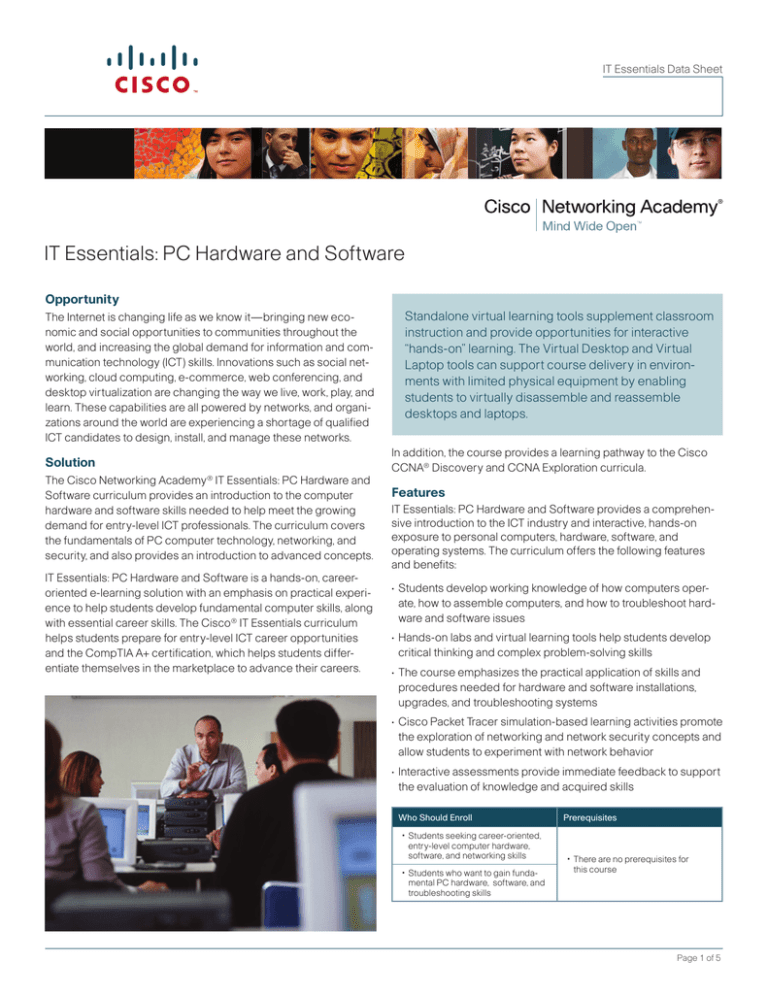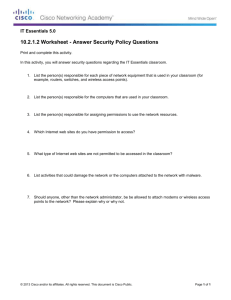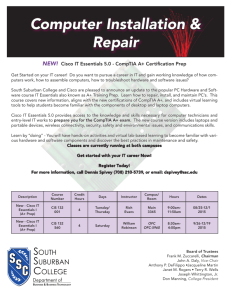
IT Essentials Data Sheet
IT Essentials: PC Hardware and Software
Opportunity
The Internet is changing life as we know it—bringing new economic and social opportunities to communities throughout the
world, and increasing the global demand for information and communication technology (ICT) skills. Innovations such as social networking, cloud computing, e-commerce, web conferencing, and
desktop virtualization are changing the way we live, work, play, and
learn. These capabilities are all powered by networks, and organizations around the world are experiencing a shortage of qualified
ICT candidates to design, install, and manage these networks.
Solution
The Cisco Networking Academy® IT Essentials: PC Hardware and
Software curriculum provides an introduction to the computer
hardware and software skills needed to help meet the growing
demand for entry-level ICT professionals. The curriculum covers
the fundamentals of PC computer technology, networking, and
security, and also provides an introduction to advanced concepts.
IT Essentials: PC Hardware and Software is a hands-on, careeroriented e-learning solution with an emphasis on practical experience to help students develop fundamental computer skills, along
with essential career skills. The Cisco® IT Essentials curriculum
helps students prepare for entry-level ICT career opportunities
and the CompTIA A+ certification, which helps students differentiate themselves in the marketplace to advance their careers.
Standalone virtual learning tools supplement classroom
instruction and provide opportunities for interactive
“hands-on” learning. The Virtual Desktop and Virtual
Laptop tools can support course delivery in environments with limited physical equipment by enabling
students to virtually disassemble and reassemble
desktops and laptops.
In addition, the course provides a learning pathway to the Cisco
CCNA® Discovery and CCNA Exploration curricula.
Features
IT Essentials: PC Hardware and Software provides a comprehensive introduction to the ICT industry and interactive, hands-on
exposure to personal computers, hardware, software, and
operating systems. The curriculum offers the following features
and benefits:
• Students develop working knowledge of how computers operate, how to assemble computers, and how to troubleshoot hardware and software issues
• Hands-on labs and virtual learning tools help students develop
critical thinking and complex problem-solving skills
• The course emphasizes the practical application of skills and
procedures needed for hardware and software installations,
upgrades, and troubleshooting systems
• Cisco Packet Tracer simulation-based learning activities promote
the exploration of networking and network security concepts and
allow students to experiment with network behavior
• Interactive assessments provide immediate feedback to support
the evaluation of knowledge and acquired skills
Who Should Enroll
Prerequisites
• Students seeking career-oriented,
entry-level computer hardware,
software, and networking skills
• Students who want to gain funda-
• There are no prerequisites for
this course
mental PC hardware, software, and
troubleshooting skills
Page 1 of 5
IT Essentials Data Sheet
21st Century Skills
IT Essentials: PC Hardware and Software integrates practical skills
training into the technical curriculum to help students succeed in
future educational, entrepreneurial, and occupational endeavors.
In addition to learning the fundamentals of hardware, software, and
operating systems, students develop problem solving, critical thinking, collaboration, communication, and negotiation skills, which can
help them succeed in the 21st century global workplace.
Assessments
Innovative formative and summative assessments are integrated into
the IT Essentials: PC Hardware and Software curriculum and supported by an advanced online delivery system. Immediate, rich feedback supports instructor and student evaluation of acquired knowledge and skills. Assessments can be as simple as a multiple choice
question or as complex as troubleshooting a simulated network.
Packet Tracer
Packet Tracer is a powerful network simulation program developed
by Networking Academy that allows students to experiment with network behavior and ask “what if” questions. As an integral part of the IT
Essentials curriculum, Packet Tracer provides simulation, visualization,
authoring, assessment, and collaboration capabilities and facilitates
the process of teaching and learning computer technology concepts.
Packet Tracer supplements physical equipment by allowing students
to create a network with an almost unlimited number of devices;
encouraging open learning, practice, discovery, and troubleshooting.
The simulation-based learning environment helps students develop
21st century skills such as decision making, creativity, critical thinking,
and problem solving.
Course Description
The IT Essentials: PC Hardware and Software course covers the
fundamentals of PC hardware and software as well as advanced
concepts. It is designed for students who want to pursue careers
in ICT and students who want to gain practical knowledge of how a
computer works.
IT Essentials: PC Hardware and Software encourages
students to explore networking concepts using tools
such as Packet Tracer. Packet Tracer is a powerful network simulation tool developed by Cisco that allows students to experiment with network behavior and develop
critical thinking, collaboration, and problem solving
skills, while gaining practical knowledge.
Students who complete this course will be able to describe the
internal components of a computer, assemble a computer system,
install an operating system, and troubleshoot using system tools and
diagnostic software. Students will also be able to connect to the Internet and share resources in a network environment. Additional topics
covered include laptops and portable devices, wireless connectivity
and basic implementation skills, Voice over Internet Protocol (VoIP),
security, safety and environmental issues, applied network configuration and troubleshooting skills, and communication skills.
Hands-on lab activities and virtual learning tools are essential elements that are integrated into the curriculum. The Virtual Laptop and
Virtual Desktop are standalone tools that enable students to virtually
disassemble and reassemble desktop and laptop computers. Both
tools are designed to supplement classroom learning and provide
an interactive “hands-on” experience in environments with limited
physical equipment.
Course Outline
Part 1—Fundamentals
Chapter Outline
Goals
1. Introduction to the
Personal Computer
• Identify and describe the various components
2. Safe Lab Procedures
and Tool Use
• Identify and describe tools used for computer
3. Computer Assembly
Step-by-Step
• Describe the assembly of a personal computer
4. Basics of Preventive
Maintenance and
Troubleshooting
• Describe the purpose of preventive maintenance
5. Fundamental
Operating Systems
• Describe operating system capabilities, the
6. Fundamental
Laptops and
Portable Devices
• Identify and describe the main components of
7. Fundamental
Printers and Scanners
• Identify and describe the differences between
8. Fundamental
Networks
• Identify and describe basic network components,
9. Fundamental
Security
• Identify and describe security threats,
10. Communication Skills
• Describe professional skills and communication
that make up a personal computer and define
information technology
service and explain how to use those tools safely
and basic troubleshooting steps
installation process, navigation, basic preventive
maintenance, and troubleshooting
laptops and portable devices, basic preventive
maintenance, and troubleshooting
printers and scanners, installation and
configuration, basic preventive maintenance,
and troubleshooting
technologies, basic preventive maintenance,
and troubleshooting
procedures, basic preventive maintenance,
and troubleshooting
techniques
Page 2 of 5
IT Essentials Data Sheet
Industry-Recognized Certification
Course Outline (continued)
Part 2—Advanced
Chapter Outline
Goals
11. Advanced
Personal Computers
• Describe the process for replacing or upgrad-
12. Advanced
Operating Systems
• Describe the processes used to install, upgrade,
13. Advanced
Laptops and
Portable Devices
• Describe the process for replacing or upgrading
14. Advanced
Printers and
Scanners
• Install and configure local and shared network
15. Advanced Networks
• Design and implement a basic network based
16. Advanced Security
• Implement security measures based on customer
ing personal computer components and apply
preventive maintenance and troubleshooting
techniques
configure, and optimize a computer operating
system, and apply preventive maintenance and
troubleshooting techniques
laptop or portable device components, describe
common wireless communication technologies,
and apply preventive maintenance and troubleshooting techniques
printers and scanners, and apply preventive
maintenance and troubleshooting techniques
on customer requirements and apply preventive
maintenance and troubleshooting techniques
requirements and apply preventive maintenance
and troubleshooting techniques
As a CompTIA Authorized Quality Curriculum, IT Essentials: PC
Hardware and Software helps students prepare for the CompTIA
A+ certification (www.comptia.org). The fundamentals part of the
course, chapters 1–10, helps students prepare for the CompTIA
A+ Essentials exam (220-701), which covers the fundamentals of
computer technology, networking, and security, and validates the
communication skills and professionalism required of all entrylevel IT professionals.
The advanced part of the course, chapters 11–16, helps students
prepare for the CompTIA A+ Practical Application exam (220702), which builds on the CompTIA A+ Essentials knowledge and
skills, with more of a hands-on orientation and scenarios in which
troubleshooting and tools must be applied to resolve problems.
Students must pass both exams to earn the CompTIA A+ certification.
This course also aligns with the objectives in the first two modules
of the European Certification of Informatics Professionals (EUCIP)
IT Administrator certification (www.eucip.org): Module 1 PC
Hardware, and Module 2 Operating Systems.
Careers
Upon completion of the IT Essentials: PC Hardware and Software
course, students will be able to perform the following tasks:
• Define information technology (IT) and describe the components
of a personal computer
• Describe how to protect self, equipment, and the environment
from accidents, damage, and contamination
• Perform a step-by-step assembly of a desktop computer and
install and navigate an operating system
• Explain and perform preventive maintenance
• Explain the steps of the troubleshooting process and perform
basic troubleshooting
• Upgrade or replace components of a laptop, printer, or scanner
based on customer needs
• Configure computers to attach to an existing network
• Implement basic physical and software security principles
•Apply good communications skills and professional behavior
while working with customers
• Assess customer needs, analyze possible configurations, and
provide solutions or recommendations for hardware, operating
systems, networking, and security
The IT Essentials: PC Hardware and Software curriculum supports
students who want to prepare for entry-level positions in the ICT
field. Job titles include enterprise technician, IT administrator, field
service technician, call center technician, help desk technician,
and PC or support technician.
Translated and Accessible
We are committed to making our courses and documentation
accessible and usable by all students to help them achieve their
goals. Translation of the IT Essentials: PC Hardware and Software
curriculum improves student outcomes by facilitating learning
success on a global scale. Our translation strategy is focused
on the following United Nations (UN) languages: English, Arabic,
French, Russian, and Spanish. These languages are spoken by
more than 50 percent of the world’s population.
IT Essentials: PC Hardware and Software is currently available in
English, Arabic, French, Russian, and Spanish, and many other
language versions have been developed by Networking Academy
partners and community members.
IT Essentials: PC Hardware and Software is also compatible with
screen readers for students with accessible needs—including
those with visual and dexterity limitations.
Learning Environment
Minimum System Requirements
IT Essentials: PC Hardware and Software can be delivered as an
independent curriculum or integrated into a broader course of
study, such as technology or continuing education programs. The
curriculum can be offered in an in-person or a blended distance
learning (BDL) environment.
For the optimal student learning experience, we recommend
a typical lab size of 12 to 15 students and a ratio of one lab
PC per student. A ratio of one lab PC for two students is the
minimum acceptable for the hands-on lab activities. Some of
the lab activities require the student lab PCs to be connected
to a local network.
Page 3 of 5
IT Essentials Data Sheet
The student lab PCs will be in various states of assembly and
repair during the course and therefore are not suitable for viewing
the curriculum content.
Lab PC Software Requirements
Lab PC Hardware Requirements
Microsoft Windows XP Professional (Media CD) is needed to complete the curriculum labs.
PC Tower Case with 300W power supply
1
PCI, PCIe, or AGP-compatible motherboard
1
Microsoft offers programs for academic institutions to purchase
software at a reduced cost. An example of such a program is the
MSDN Academic Alliance, which can be found at http://msdn.
microsoft.com/academic. Please visit the Microsoft website for
your country or region to learn more.
Intel Pentium/Celeron family, AMD K6/Athlon/Duron family, or compatible
processor, 300 MHz or faster recommended
1
Lab PC Repair Tools
Cooling fan and heat sink
1
The computer toolkit should include the following tools:
Description
Qty
128 MB memory modules (minimum) or 256 MB memory modules
(recommended)
• Some labs will require one module of RAM to be uninstalled or the
simulation of a faulty module for troubleshooting purposes.
• 128 MB is the minimum requirement to run the full functions of
Windows XP Pro.
Floppy drive
• Phillips screwdriver
2
• Hex Socket Drivers (various sizes)
• Needle-nose pliers
1
15 GB hard drive (minimum), 20 GB or more (recommended)
• The system must support a full install of Windows XP and two 5 GB
1
partitions.
• Electrostatic discharge (ESD) wrist strap and cord
• Electrostatic discharge (ESD) mat with a ground cord
• Safety glasses
CD-ROM (minimum) or 24x CD/DVD-ROM (recommended)
1
Ethernet card
1
PCI, PCIe (recommended), or AGP video card
1
Ribbon cables to connect HDD/CD/Floppy
•Flathead screwdriver
Varies
• Lint-free cloth
• Electronics cleaning solution
• Flashlight
Mouse
1
• Thermal compound
Keyboard
1
• Multimeter
Super VGA (800 x 600) or higher-resolution video monitor
1
• Compressed air service canister (optional due to globally varying
classroom health and safety laws)
Note: The equipment listed above is the minimum set and can be
substituted with equal or higher specifications.
• Power supply tester (optional)
• Cable testers (optional)
• Network Loop back plugs (optional
Additional Requirements and Resources
Minimum:
• One Internet connection for Internet searches and driver downloads (this could be the instructor’s workstation)
• One integrated printer/scanner/copier for the class to share
• One Linksys wireless router/switch or equivalent for the class to
share, Linksys model WRT 300N preferred
• Two Wireless PCI network adapters (compatible with the above
wireless router/switch) for the class to share
Recommended:
• One Internet connection for each student to conduct Internet
searches and download drivers
• One integrated printer/scanner/copier per two lab PCs
• One Linksys wireless router/switch or equivalent per two lab
PCs, Linksys model WRT 300N preferred
• One Wireless PCI network adapter (compatible with the above
wireless router/switch) for each lab PC
Page 4 of 5
IT Essentials Data Sheet
Cisco Networking Academy
In partnership with schools and organizations around the world,
the Cisco Networking Academy program delivers a comprehensive learning experience to help students develop ICT skills
for entry-level career opportunities, continuing education, and
globally recognized career certifications. The courses also help
students build 21st century skills such as collaboration and problem solving by encouraging practical application of knowledge
through hands-on activities and network simulations.
Networking Academy teaches ICT skills to students from virtually every socioeconomic background and region of the world.
Students gain the skills needed to pursue networking careers in
a variety of industries such as technology, healthcare, financial
services, fashion, entertainment, and more. Students also gain
access to a global support group, career developments tools, and
social networking resources to help them become architects of
the human network.
For More Information
Cisco Networking Academy www.cisco.com/go/netacad
Course and Certifications www.cisco.com/go/netacadcourses
Locate an academy www.cisco.com/go/academylocator
©2010 Cisco Systems, Inc. All rights reserved. CCNA, CCNP, Cisco, the Cisco logo, Cisco Systems, and Networking Academy are registered trademarks or trademarks of Cisco Systems, Inc. and/or its affiliates in the United States and certain other countries. All other trademarks mentioned in this document or Website are
the property of their respective owners. The use of the word partner does not imply a partnership relationship between Cisco and any other company. (1002R)
C78-587889-00 3/10
Page 5 of 5


